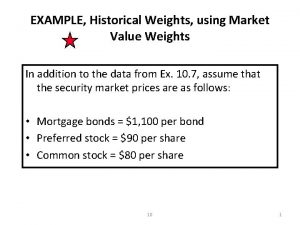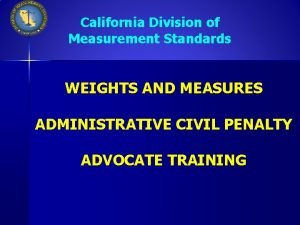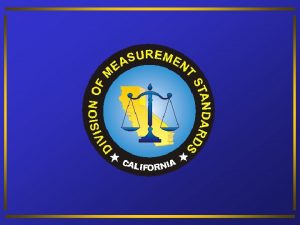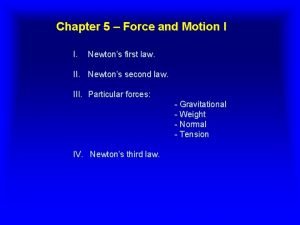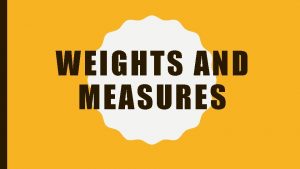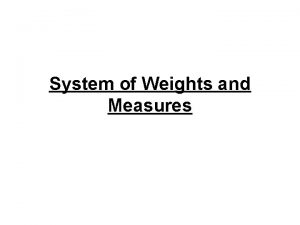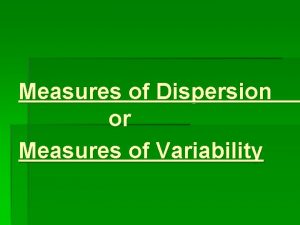System of Weights and Measures System of Weights










- Slides: 10

System of Weights and Measures

System of Weights and Measures • The international system of units is generally accepted for use in pharmacy. • Units of mass (weights): – The base unit for mass is the kilogram (kg), the units of mass commonly used in pharmacy are: Name Abbreviation Equivalent 1 kilogram Kg 1000 gm 1 gram Gm 1000 mg 1 milligram Mg 1000 ug (mcg) 1 microgram Ug (mcg) 1000 ng 1 nanogram Ng 1000 pc (pictogram)

Units of amount of substance: • The base unit for amount of substance is the mole (mol) Name Abbreviation Equivalent 1 Mole Mol 1000 m mol 1 Millimole m mol 1000 u mol 1 Micromole U mol 1/1000 m mol

Units of Capacity (volume): • The use of liter and milliliter are universal in pharmacy practice. One liter is defined in U. K. as one cubic decimeter. Name Abbreviation Equivalent 1 liter L 1000 ml 1 milliliter Ml 1000 ul 1 microliter µl 1/1000 ml

Units of concentration: • Concentration may be expressed in two ways: • Mass concentration: expressed as gm/L • Amount of substance concentration: expressed as mol/L • In pharmacy the drug concentration in solution is usually expressed as mass concentration (gm/L) • The concentration of electrolytes in solution for parental expressed as (mol/L)

Units of length: • The meter (m) is the base unit Name Abbreviation Equivalent 1 centimeter cm 10 mm 1 millimeter mm 1000 um 1 micrometer um 1000 nm (nanometer)

Types of Calculations: • Working from a master formula: • The master formula may list the ingredients for a total quantity greater than or less than the amount requires to be prepared. The formula must therefore be scaled down or scaled up. • Example: calculate the amount of the ingredients for 510 ml and 900 ml from the master formula of opiate squill linctus: Ingredients Master formula Scaled down Scaled up Squill Oxymel 150 ml 300 ml Camphorated opium tincture 150 ml 300 ml Total syrup 150 ml 300 ml Total Volume 450 ml 150 ml 900 ml

Dealing with percentage concentrations: • Many pharmaceutical preparations consist of solutions of solids in liquids, solutions of liquids in liquids or admixtures of liquids in solids with solids. The proportions of the different components of these systems are often expressed as "percentages" the term "percentages" in pharmaceutical calculations should be qualified to indicate whether the solution is weight in volume (W/V) weight in weight (W/W) or volume in volume (V/V).

Definitions: • "Percentage W/V indicates the number of grams of ingredient in 100 milliliters of product" • The strength of a pharmaceutical solution of a solid in liquid is expressed as % W/V

Concentrations expressed as parts: • The strength of some pharmaceutical solutions as expressed as "parts" of dissolved substance in "parts" of solution (e. g. 1/1000). In solutions of solids in liquid this means parts by weight (gm) in parts by volume (milliliters) of final solution. • In solutions of liquid in liquid, parts by volume (milliliters) of dissolved liquids in parts by volume (milliliters) of the final solutions. • It is useful to convert "parts" into percentages e. g. – – – 1 in 100 = 1% 1 in 200 = 0. 5% 1 in 500 = 0. 2% 1 in 800 = 0. 125% 1 in 1000 = 0. 1%
 Historical weights
Historical weights Abbreviations and food weights and measures worksheet key
Abbreviations and food weights and measures worksheet key Module 7 weights and measures
Module 7 weights and measures Concrete construction estimating
Concrete construction estimating California weights and measures
California weights and measures California weights and measures
California weights and measures Repeated measures design
Repeated measures design Unlocking the secrets of mohenjodaro
Unlocking the secrets of mohenjodaro Dr. dudley sargent invented 80 machines, using
Dr. dudley sargent invented 80 machines, using The two blocks a and b have weights
The two blocks a and b have weights Ipfraking
Ipfraking
